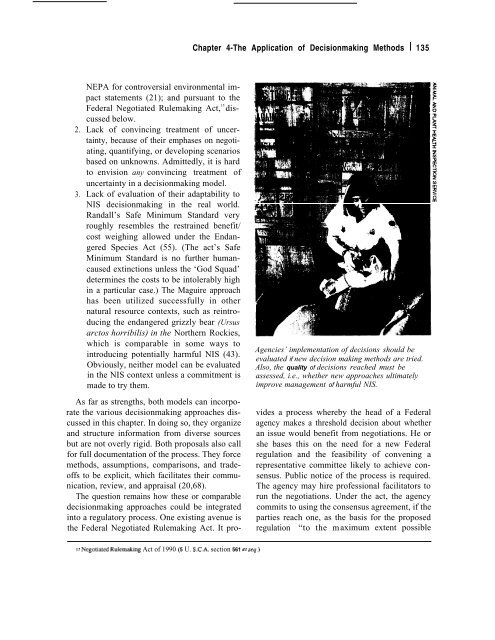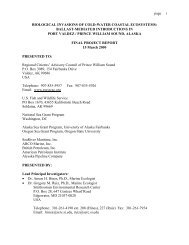- Page 1 and 2:
Harmful Non-Indigenous Species in t
- Page 3 and 4:
ForewordNon-indigenous species (NIS
- Page 5 and 6:
EXECUTIVE BRANCH LIAISONSGary H. Jo
- Page 7 and 8:
c ontents1 Summary, Issues and Opti
- Page 9 and 10:
Issues,andOptions 1The movement of
- Page 11 and 12:
l-Summary, Issues, and Options 3Tab
- Page 13 and 14:
l-Summary, Issues, and Options 5Tab
- Page 15 and 16:
l-Summary, Issues, and Options 7Mor
- Page 17 and 18:
l-Summary, Issues, and Options 9Tab
- Page 19 and 20:
l--Summary, Issues, and Options 11t
- Page 21 and 22:
1-Summary, Issues, and Options 13fo
- Page 23 and 24:
I-Summary, Issues, and Options 15
- Page 25 and 26:
l-Summary, Issues, and Options I 17
- Page 27 and 28:
l-Summary, Issues, and Options I 19
- Page 29 and 30:
l--Summary, Issues, and Options 21T
- Page 31 and 32:
l-Summary, Issues, and Options 23Bo
- Page 33 and 34:
l-Summary, Issues, and Options 25te
- Page 35 and 36:
l-Summary, Issues, and Options I 27
- Page 37 and 38:
l-Summary, Issues, and Options 29Bo
- Page 39 and 40:
l--Summary, Issues, and Options I 3
- Page 41 and 42:
I-Summary, Issues, and Options 33in
- Page 43 and 44:
l-Summary, Issues, and Options 35in
- Page 45 and 46:
1-Summary, Issues, and Options 37lu
- Page 47 and 48:
l-Summary, Issues, and Options I 39
- Page 49 and 50:
I-Summary, Issues, and Options 41of
- Page 51 and 52:
1-Summary, Issues, and Options 43la
- Page 53 and 54:
1-Summary, Issues, and options 45Th
- Page 55 and 56:
1-Summary, Issues, and Options 47to
- Page 57 and 58:
1-Summary, Issues, and Options 49se
- Page 59 and 60:
The Consequencesof HarmfulNon-Indig
- Page 61 and 62:
Chapter 2—The Consequences of Har
- Page 63 and 64:
Chapter 2—The Consequences of Har
- Page 65 and 66:
Chapter 2—The Consequences of Har
- Page 67 and 68:
Chapter 2-The Consequences of Harmf
- Page 69 and 70:
Chapter 2—The Consequences of Har
- Page 71 and 72:
Chapter 2-The Consequences of Harmf
- Page 73 and 74:
Chapter 2—The Consequences of Har
- Page 75 and 76:
Chapter 2-The Consequences of Harmf
- Page 77 and 78:
Chapter 2—The Consequences of Har
- Page 79 and 80:
Chapter 2-The Consequences of Harmf
- Page 81 and 82:
Chapter 2—The Consequences of Har
- Page 83 and 84:
Chapter 2-The Consequences of Harmf
- Page 85 and 86:
Non-indigenous species (NIS) arrive
- Page 87 and 88:
3-The Changing Numbers, Causes, and
- Page 89 and 90:
3—The Changing Numbers, Causes, a
- Page 91 and 92: 3—The Changing Numbers, Causes, a
- Page 93 and 94: 3—The Changing Numbers, Causes, a
- Page 95 and 96: 3—The Changing Numbers, Causes, a
- Page 97 and 98: 3-The Changing Numbers, Causes, and
- Page 99 and 100: 3—The Changing Numbers, Causes, a
- Page 101 and 102: 3—The Changing Numbers, Causes, a
- Page 103 and 104: 3—The Changing Numbers, Causes, a
- Page 105 and 106: 3-The Changing Numbers, Causes, and
- Page 107 and 108: 3—The Changing Numbers, Causes, a
- Page 109 and 110: 3—The Changing Numbers, Causes, a
- Page 111 and 112: 3-The Changing Numbers, Causes, and
- Page 113 and 114: 3—The Changing Numbers, Causes, a
- Page 115 and 116: TheApplication ofDecisionmakingMeth
- Page 117 and 118: Chapter 4-The Application of Decisi
- Page 119 and 120: Chapter 4-The Application of Decisi
- Page 121 and 122: Chapter 4-The Application of Decisi
- Page 123 and 124: Chapter 4-The Application of Decisi
- Page 125 and 126: Chapter 4-The Application of Decisi
- Page 127 and 128: Chapter 4-The Application of Decisi
- Page 129 and 130: Chapter &The Application of Decisio
- Page 131 and 132: Chapter 4-The Application of Decisi
- Page 133 and 134: Chapter 4-The Application of Decisi
- Page 135 and 136: NOTES:1. Direct effects and costs w
- Page 137 and 138: Chapter 4-The Application of Decisi
- Page 139 and 140: Chapter 4-The Application of Decisi
- Page 141: Chapter 4-The Application of Decisi
- Page 145 and 146: .Technologiesfor PreventingandManag
- Page 147 and 148: Chapter 5-Technologies for Preventi
- Page 149 and 150: Chapter 5-Technologies for Preventi
- Page 151 and 152: Chapter 5-Technologies for Preventi
- Page 153 and 154: Chapter 5-Technologies for Preventi
- Page 155 and 156: Chapter 5--Technologies for Prevent
- Page 157 and 158: Chapter 5-Technologies for Preventi
- Page 159 and 160: Chapter 5-Technologies for Preventi
- Page 161 and 162: Chapter 5-Technologies for Preventi
- Page 163 and 164: Chapter 5-Technologies for Preventi
- Page 165 and 166: Chapter 5-Technologies for Preventi
- Page 167 and 168: Chapter 5-Technologies for Preventi
- Page 169 and 170: Chapter 5-Technologies for Preventi
- Page 171 and 172: A PrimeronFederalPolicy 6This chapt
- Page 173 and 174: Chapter 6—A Primer on Federal Pol
- Page 175 and 176: Chapter 6-A Primer on Federal Polic
- Page 177 and 178: Chapter 6-A Primer on Federal Polic
- Page 179 and 180: Chapter 6-A Primer on Federal Polic
- Page 181 and 182: Chapter 6-A Primer on Federal Polic
- Page 183 and 184: Chapter 6-A Primer on Federal Polic
- Page 185 and 186: Chapter 6—A Primer on Federal Pol
- Page 187 and 188: Chapter 6-A Primer on Federal Polic
- Page 189 and 190: Chapter 6-A Primer on Federal Polic
- Page 191 and 192: Chapter 6-A Primer on Federal Polic
- Page 193 and 194:
Chapter 6-A Primer on Federal Polic
- Page 195 and 196:
.Chapter 6-A Primer on Federal Poli
- Page 197 and 198:
Chapter 6-A Primer on Federal Polic
- Page 199 and 200:
Chapter 6-A Primer on Federal Polic
- Page 201 and 202:
Chapter 6-A Primer on Federal Polic
- Page 203 and 204:
Chapter 6-A Primer on Federal Polic
- Page 205 and 206:
Chapter 6-A Primer on Federal Polic
- Page 207 and 208:
Chapter 6-A Primer on Federal Polic
- Page 209 and 210:
State and LocalApproachesFrom aNati
- Page 211 and 212:
Chapter 7-State and Local Approache
- Page 213 and 214:
Chapter 7-State and Local Approache
- Page 215 and 216:
Chapter 7-State and Local Approache
- Page 217 and 218:
Chapter 7-State and Local Approache
- Page 219 and 220:
Chapter 7-State and Local Approache
- Page 221 and 222:
Chapter 7-State and Local Approache
- Page 223 and 224:
Chapter 7-State and Local Approache
- Page 225 and 226:
Chapter 7-State and Local Approache
- Page 227 and 228:
Chapter 7-State and Local Approache
- Page 229 and 230:
Chapter 7-State and Local Approache
- Page 231 and 232:
Chapter 7-State and Local Approache
- Page 233 and 234:
Chapter 7-State and Local Approache
- Page 235 and 236:
Chapter 7-State and Local Approache
- Page 237 and 238:
Chapter 7-State and Local Approache
- Page 239 and 240:
Chapter 7-State and Local Approache
- Page 241 and 242:
234 I Harmful Non-Indigenous Specie
- Page 243 and 244:
236 I Harmful Non-Indigenous Specie
- Page 245 and 246:
238 Harmful Non-Indigenous Species
- Page 247 and 248:
240 Harmful Non-Indigenous Species
- Page 249 and 250:
242 I Harmful Non-Indigenous Specie
- Page 251 and 252:
244 I Harmful Non-Indigenous Specie
- Page 253 and 254:
246 I Harmful Non-Indigenous Specie
- Page 255 and 256:
248 I Harmful Non-Indigenous Specie
- Page 257 and 258:
250 I Harmful Non-Indigenous Specie
- Page 259 and 260:
252 Harmful Non-Indigenous Species
- Page 261 and 262:
254 I Harmful Non-Indigenous Specie
- Page 263 and 264:
256 I Harmful Non-Indigenous Specie
- Page 265 and 266:
258 Harmful Non-Indigenous Species
- Page 267 and 268:
260 I Harmful Non-Indigenous Specie
- Page 269 and 270:
262 Harmful Non-Indigenous Species
- Page 271 and 272:
264 I Harmful Non-Indigenous Specie
- Page 273 and 274:
266 I Harmful Non-Indigenous Specie
- Page 275 and 276:
268 I Harmful Non-Indigenous Specie
- Page 277 and 278:
270 I Harmful Non-Indigenous Specie
- Page 279 and 280:
272 Harmful Non-Indigenous Species
- Page 281 and 282:
274 Harmful Non-Indigenous Species
- Page 283 and 284:
276 I Harmful Non-Indigenous Specie
- Page 285 and 286:
278 I Harmful Non-Indigenous Specie
- Page 287 and 288:
280 Harmful Non-Indigenous Species
- Page 289 and 290:
282 Harmful Non-Indigenous Species
- Page 291 and 292:
284 I Harmful Non-Indigenous Specie
- Page 293 and 294:
The Contextof the Future:Internatio
- Page 295 and 296:
Chapter 10-The Context of the Futur
- Page 297 and 298:
Chapter 10-The Context of the Futur
- Page 299 and 300:
Chapter 10-The Context of the Futur
- Page 301 and 302:
Chapter 10-The Context of the Futur
- Page 303 and 304:
Chapter 10—The Context of the Fut
- Page 305 and 306:
Chapter 10-The Context of the Futur
- Page 307 and 308:
Chapter 10-The Context of the Futur
- Page 309 and 310:
Chapter 10-The Context of the Futur
- Page 311 and 312:
Chapter 10-The Context of the Futur
- Page 313 and 314:
Appendix A:List ofBoxes,Figures,and
- Page 315 and 316:
Appendix A: List of Boxes, Figures,
- Page 317 and 318:
Appendix B:Authors, WorkshopPartici
- Page 319 and 320:
Appendix B: Authors, Workshop Parti
- Page 321 and 322:
Appendix B: Authors, Workshop Parti
- Page 323 and 324:
Appendix B: Authors, Workshop Parti
- Page 325 and 326:
Appendix C:ReferencesCHAPTER 1: SUM
- Page 327 and 328:
Appendix C: References 132135.36.37
- Page 329 and 330:
Appendix C: References 32377.78.79.
- Page 331 and 332:
Appendix C: References I 325116.117
- Page 333 and 334:
Appendix C: References ! 32728.29.3
- Page 335 and 336:
Appendix C: References 132971. Scho
- Page 337 and 338:
Appendix C: References ! 33116,17.1
- Page 339 and 340:
Appendix C: References I 3335859 %6
- Page 341 and 342:
Appendix C: References 1335101,102.
- Page 343 and 344:
Appendix C: References I 33733.34.3
- Page 345 and 346:
Appendix C: References I 33974.75.7
- Page 347 and 348:
Appendix C: References 134132.33.34
- Page 349 and 350:
Appendix C: References 134371.72.73
- Page 351 and 352:
Appendix C: References 13457.8.9.10
- Page 353 and 354:
Appendix C: References 134746. Heck
- Page 355 and 356:
Appendix C: References 134986.87.88
- Page 357 and 358:
Appendix C: References 1351127. U.S
- Page 359 and 360:
Appendix C: References 13533.4.5.6.
- Page 361 and 362:
Appendix C: References 35543.44.45.
- Page 363 and 364:
Appendix C: References ! 35713.14.1
- Page 365 and 366:
Appendix C: References! 35958. Joyc
- Page 367 and 368:
Appendix C: References I 361102. Sh
- Page 369 and 370:
Appendix C: References 13636.7.8.9.
- Page 371 and 372:
Appendix C: References I 36543.44.4
- Page 373 and 374:
Appendix C: References 136733.34.35
- Page 375 and 376:
—Appendix C: References 36975.76.
- Page 377 and 378:
Index toCommon andScientificNames o
- Page 379 and 380:
Index to Common and Specific Names
- Page 381 and 382:
Index to Common and Specific Names
- Page 383 and 384:
—Index to Common and Specific Nam
- Page 385 and 386:
Index to Common and Specific Names
- Page 387 and 388:
Index I 381Army Corps of Engineers,
- Page 389 and 390:
Index 1383of control technologies,
- Page 391 and 392:
Index 1385brown tree snake, 76, 177
- Page 393 and 394:
Index 1387agency smeys, 210-212numb
- Page 395 and 396:
Pacitlc Marine Fisheries Commission
- Page 397:
Index 1391prevention technologies,














